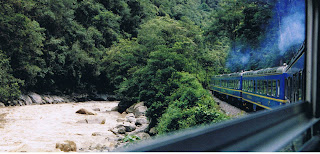Sometimes we are asked where is the best place we have visited. That is not an easy question, and the answer really depends on the context. Suppose you asked me to name the one place on this walkabout that I would be most unhappy to be told that I could never go there again. I would unhesitatingly answer "Cape Cod." Yes, it can be touristy, and no, it is not exactly exotic. But the Cape really appealed to me. I can't really explain why that it is so, but I know that it is so. Cape Cod over Viña del Mar? Actually, yes! That doesn't mean that I don't like Viña. And I do have to admit that I like Paris.
Where on this walkabout do I most want not to visit again? Also without hesitation or second thought: Ciudad del Este, Paraguay. Some place are like that! I have been to Port-au-Prince and hope I never go again.
Sometimes those who ask such questions are looking for ideas for their own travels. So one might ask, "Where in South America should I go?" We have spent about nine months here over the past six years. I can also answer that one without hesitation or second thought.
If you are going to South America only once in your life, and are limited by time as to the length of your itinerary, then go to Macchu Picchu. No doubt about it!
How do you do that? Fly to Lima, the capital of Peru that is located on the Pacific coast. You should stay there for two days before proceeding to Cuzco. One of those two days will be needed to recover from the long flight. A wide range of accommodations are available in the Miraflores and Barranco areas of Lima. Everything from luxury hotels that might make you think you are in Los Angeles to backpacker hostels that will leave no doubt in your mind that you are not in Los Angeles. (That is a good thing!)
There are two ways to get to Macchu Picchu from Cuzco. One is a guided group hike of a few days' duration. The other is to take the train. When we went, one had to buy the train tickets in Cuzco. Now, the railway has a ticket office in the Larcomar shopping center in Miraflores. Buy the tickets there before you leave Lima for Cuzco. Give yourself at least a day in Cuzco to adapt to the altitude. Preferably two days.
Let's not get ahead of ourselves. How to get from Lima to Cuzco? You could do it by bus, but I don't recommend this. It could be more adventurous than you really want. See my earlier blog post on bus travel in South America. I usually recommend it, but not in this case. We flew Star Peru round trip and booked those tickets while in the US. Another option would be LAN, the Chilean airline that has a Peruvian subsidiary integrated into its system. We would probably use that one were we to go now because LAN is a OneWorld partner with American Airlines, where we have our mileage accounts, but it isn't the only way.
Cuzco is a great town. It seems in many ways a spy-hole into the colonial past, and it is a different Peru than the one that you will see in Lima. We stayed in at Torre Dorado, which we highly recommend.
A trip to Macchu Picchu is an adventure, but it is do-able. You don't have to be in shape for service in the commandos to go there. We went with my 85-year old mother-in-law. She is pretty spry for her age, and she didn't do any climbing when she got into the Macchu Picchu park itself. The bus from the train station takes you up to the park entrance, which is about halfway up the mountain slope upon which the phenomenal complex sits. So those who want to take the walking a little easier are able to enjoy the experience just like those who want to use it as a stair-climbing trainer.
However you do it, it will be the experience of a lifetime, and one that extends your personal limits. Go to Macchu Picchu. You won't regret it!
Here are a few photos:
Above and below are views of Macchu Picchu. It is hard not to take a photo that looks like one of those old Pan American Airways travel posters!
A view from the train from Cuzco to Macchu Picchu.
Two views of the Plaza de Armas in Cuzco.
Lima's cathedral in its Plaza de Armas.
Parque Kennedy in Miraflores.





